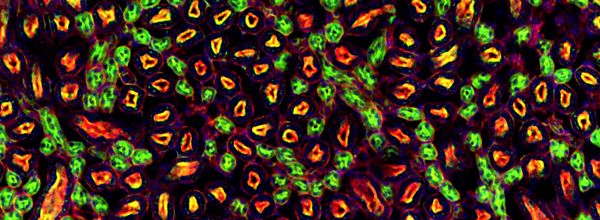In Part 1 of these articles, you’ll have learnt about common microscope light sources and how to replace and align these correctly.
In this article, we will discuss the importance of Köhler illumination and how to set up the microscope to achieve optimal imaging results.
What is Köhler illumination?
Before discussing this technique, let us go back to the late 19th Century and the origins of the procedure. The main sources of illumination for microscopy at this time were not only inconsistent, but also had the tendency to produce unwanted glare. Illumination commonly relied on the heating of the element zirconium which produced an intensely bright chemical light known as ‘zirconia light’, or the ‘Auer gas light’ (named after the scientist Baron Carl Auer von Welsbach). Although the Auer light was described as being suitable for microscopy, it had the undesirable side effects of producing carbonic acid and relatively large amounts of heat.
Köhler illumination is named after the inventor of the technique, August Köhler (1866-1948). At the time of invention, he was working on photomicroscopy that required long-term exposure of emulsion plates and not helped by the unreliable light sources. In 1893, Köhler published a paper which set out a method to overcome these problems and explained his technique for correct alignment of the microscope to provide a homogenous illumination of the specimen of interest. Following the publication, Köhler was invited to join the Carl Zeiss Company in 1900 where he worked for the next 45 years.
Köhler illumination is one of the most important specimen lighting techniques to date. The correct set up produces an evenly illuminated field of view, ensures that you have optimal contrast in your specimens, will increase the overall resolution of the microscope, and provides more imaging data from your experiments. Although the method can be overlooked by microscopists and perceived as somewhat time-consuming, once you are familiar with it, this technique can easily be applied each time you start an imaging session.
How to set up an upright microscope for Köhler illumination
ZEISS have produced an excellent tutorial video which guides you through each of the stages of Köhler illumination for an upright microscope.

Before setting up the microscope for Köhler illumination, make sure that the bulb is correctly aligned (as covered in Part 1 of these articles). Although the tutorial video describes the procedure for the ZEISS Axio Imager microscope, the description of the technique can be applied to any microscope.
- Switch on the microscope at the power supply and adjust the brightness of the lamp to a comfortable level. If no light reaches your sample, press the ‘TL’ button on the microscope (if available).
- Set up the eyepieces so they are the correct distance apart for your eyes and adjust the diopter setting which takes into account the differences in visual perception between your eyes. For more information on diopter adjustments, see this article on Bitesize Bio.
- Lower the stage by turning the focus knobs at the side of the microscope, or press the ‘Load’ button on the attached touch screen if the microscope is equipped with one.
- Place your slide on the stage and swing in the front lens of the sub-stage condenser (if not already in place). Raise the condenser towards the stage by turning the condenser focus knobs. The condenser upper stop should be low enough to ensure that the slide does not get knocked out of place. Be sure to watch the condenser and the slide whilst you are raising the condenser instead of looking down the eyepieces.
- If the condenser has settings for multiple contrast imaging, set the condenser to ‘H’ for brightfield (which is sometimes labelled as ‘BF’). In addition, make sure that the reflector turret is set to either an empty or brightfield position.
- Turn the objectives turret round to the magnification you desire. Note that Köhler illumination can only be set up for objectives which have a magnification of 10X (or greater). Focus the specimen using the focus knobs at the side of the microscope and ensure that the sample remains in focus for the rest of the alignment as correct Köhler alignment is based on this focus.
- Close the field diaphragm until the edges of the diaphragm come into view. The field diaphragm controls the diameter of the light illuminating your sample. On the Axio Imager microscope, there are control buttons marked ‘F’ near the base of the microscope which control the diaphragm.
- Locate the sub-stage condenser focus knobs and look through the eyepieces. Adjust the condenser focus until the blades at the edge of the diaphragm come into focus.
- Locate the two centering screws under the condenser and whilst looking down the eyepieces, turn the screws until the circle of light is in the centre of your field of view.
- Open the field diaphragm back up until the edges of the diaphragm just leave the field of view.
- Remove one of the eyepieces and look down the eyepiece tube. Close the aperture diaphragm (located on the condenser) until the circle of light is around two-thirds of the size of the illuminated view. Replace the eyepiece. If you set the aperture diaphragm too small this will result in a loss of resolution in the image.
How to set up an inverted microscope for Köhler illumination
Although the method for Köhler illumination achieves the same end result in either microscope configuration, there are some differences in the set up when using an inverted microscope.
ZEISS has produced a tutorial video which explains the steps of the technique on an inverted microscope.

This tutorial explains the technique for setting up a ZEISS Axio Observer microscope and can be applied to any inverted configuration. As with the upright microscope, be sure to align the bulb correctly before proceeding.
- Switch on the power supply and microscope. Open the field diaphragm (located above the stage on the transmitted light arm) and swing the filter changer out of the light path.
- Fully open the aperture diaphragm (located on the condenser). If the condenser has multiple contrast settings, set the method to ‘H’ or ‘BF’ for brightfield.
- Swing in the 10X (or higher magnification) objective. Ensure that the reflector turret is also set to a brightfield position or a ‘DIC’ position if no empty positions are available. If there is an analyser slider under the reflector turret then slide to the open position, or remove it completely.
- Set the Optovar to 1X using the roll wheel under the reflector turret, the touch screen or the central button on the focus knob.
- Direct the optical path to the eyepieces by manually rotating the light path selector, or using the touch screen to select ‘100 % VIS’. There are two controls located on the binocular tube under the eyepieces. Move the selector to the ‘eye’ icon and remove the Bertrand lens if your microscope is equipped with one. Adjust the eyepieces as explained in step 2 of the method for an upright microscope.
- If necessary, press the ‘TL’ button and turn up the light using the roll wheel on the front of the microscope. Tilt the whole transmitted light arm back and place your slide face down on the stage. Carefully tilt the transmitted light arm back into place.
- Lower the condenser completely by turning the condenser focus knobs. Look though the eyepieces and focus on your specimen. Locate the field diaphragm and whilst looking down the eyepieces, turn the wheel to the right to close the diaphragm until the blades come into your field of view.
- Locate the condenser focus knobs and look back down the eyepieces. Turn the focus knobs until the edges of the field diaphragm blades come into focus.
- Locate the two centering screws on the condenser and whilst looking down the eyepieces, turn the screws until the circle of light is in the centre of your field of view.
- Turn the field diaphragm wheel to the left until the edges of the diaphragm just leave the field of view.
- Remove one eyepiece, look down the tube and close the aperture diaphragm (located on the condenser) until the circle of light is approximately two-thirds the size of the illuminated view. Replace the eyepiece.
An interactive tutorial and further information on Köhler illumination can be found in the ZEISS Campus by following this link.
A quick summary for setting up Köhler illumination
Once you are familiar with the steps for correct Köhler illumination, this technique will take less than a minute and ensure optimal images each time you use a microscope. Remember that Köhler illumination varies between objectives, so re-adjust the microscope if changing magnification. To summarize:
- Focus on your specimen. The remainder of the Köhler alignment steps are based on this initial focusing.
- Close the field diaphragm
- Focus the edges
- Center the light
- Open the field diaphragm until the edges just disappear from view
- Close the aperture diaphragm approximately two-thirds of the illuminated view
For an overview of Köhler illumination, read this article in the Bitesize Bio Microscopy and Imaging Channel.








